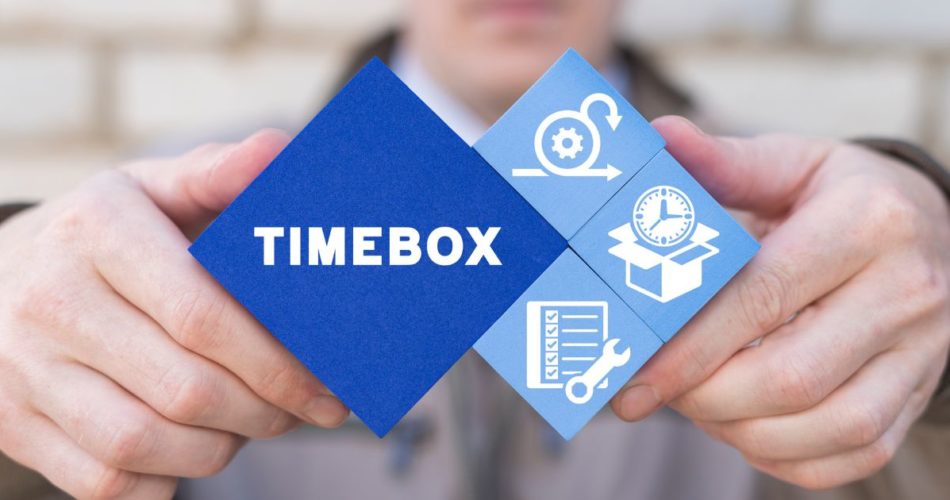<img alt="Timeboxing Techniques Making the Most of Your Workday" data- data-src="https://kirelos.com/wp-content/uploads/2023/10/echo/Timeboxing-Techniques-Making-the-Most-of-Your-Workday-800×420.jpg" data- decoding="async" height="420" src="data:image/svg xml,” width=”800″>
If you want to make the most of your time in your personal and professional life, the timeboxing technique is an efficient approach for you.
The value of time is immense, and you need to utilize it properly to maximize your productivity. There are numerous time management methods that you can use to complete your tasks at the right time. One such technique is timeboxing. In this article, I will explain your timeboxing approach and how you can implement it in various tasks.
What Is Timeboxing?
<img alt="YouTube video" data-pin-nopin="true" data-src="https://kirelos.com/wp-content/uploads/2023/10/echo/maxresdefault.jpg6523e94a89e36.jpg" height="720" nopin="nopin" src="data:image/svg xml,” width=”1280″>
As the name suggests, timeboxing is a time management approach where you assign a fixed unit of time for a particular activity. With its help, you can become more self-disciplined and organized. It also lets you become more attentive and focused on a task but not to overdo it.
By implementing this popular method, you can perform quality tasks at the lowest possible unit of time. This structured approach enables you to manage both time and tasks at the same time, leading to enhanced productivity and better work-life balance. However, you must adjust this technique as necessary for maximum benefits.
Timeboxing Technique Explained
<img alt="YouTube video" data-pin-nopin="true" data-src="https://kirelos.com/wp-content/uploads/2023/10/echo/maxresdefault.jpg6523e94a95a66.jpg" height="720" nopin="nopin" src="data:image/svg xml,” width=”1280″>
To help you understand the timeboxing method better, let me share an example with you. For instance, your manager asks you to write a business proposal for a business project. To finish this task in time, you set a timebox of 3 hours.
Within this timebox or timeframe, your focus should only be on the proposal writing. During this time, you will avoid all kinds of distractions, such as phone calls or social media notifications.
When the time is over, you need to stop the task and evaluate how much you have progressed. If necessary, you can allocate another timebox of a certain time to complete the task. But make sure you do so for better productivity and not to drag on the task unnecessarily.
Timeboxing Benefits for Anyone
- Timeboxing offers you a clear idea about the necessary time for a task so that you can allocate time effectively and prioritize tasks
- It allows you to focus on the task in your hand and concentrate more with a sense of urgency.
- With this method, you can break down your project or schedule into manageable timeboxes or chunks. This, you can easily meet your objectives.
- Timeboxing lets you allocate time for separate tasks so that you can have a better work-life balance.
- If you have the habit of procrastinating, timeboxing can motivate you to complete the tasks sooner.
- Timeboxing is also helpful in tracking work progress and understanding the achievements you have made.
- This method is also flexible and allows you to assign more timebox for a task.
How to Timebox Effectively
The timeboxing technique can be implemented effectively by categorizing it into multiple segments.
Allocate the Timebox
First of all, determine the time you want to perform a particular activity. Depending on your task complexity and preference, you can set a time limit of a few minutes or several hours.
Start Concentrating on the Task
When you know the time you have for the designated activity, you must focus on the task at hand. Make sure to avoid any kind of distractions to complete the task on time.
Evaluate Progress
Now, you must try to complete the task within the time limit or the timebox. For some reason, you may not be able to finish the task in one timebox. In that case, you can always allocate an additional timebox considering the urgency of the task.
Take a Break
While having more than one timebox, it is quite useful to have short breaks between these. You may definitely want to complete the task as soon as possible; however, taking a break actually helps you work with a fresh outlook.
Repeat as Necessary
If you work on larger projects with an array of tasks, you can break those down into various smaller timeboxing chunks. Thus, you can easily track the progress of your project and maintain focus.
Timeboxing Vs. Time Blocking
While timeboxing and time blocking both schedule a specific time for an activity, The time chunks of time blocking are longer than timeboxing.
| Features | Timeboxing | Time Blocking |
|---|---|---|
| Objective | Enables task completion on time | Structurally organizing time for tasks |
| Focus | Performing activities within the time limit | Having time blocks for various tasks |
| Allocated time | Have a time limit for tasks | Have scheduling for different activities |
| Flexibility | Can be included more timeboxing | Have some flexible structure |
| Urgency | Induces a sense of urgency | More into time allocation and prioritization |
Timeboxing Vs. To-Do List
These two time management techniques are completely different. In timeboxing, you have
a specific amount of time to complete a task. However, in a to-do list, you just enlist all the tasks you want to complete within a day or week without any time frame to complete each task.
| Features | Timeboxing | To-Do List |
|---|---|---|
| Usage | Used for time-sensitive tasks | Used for any important tasks, time-sensitive or not |
| Time limit | Tasks are done in a fixed time | Tasks do not have any fixed time to complete |
| Flexibility | Have a limited flexibility | Have complete flexibility |
| Urgency level | Involves stress and urgency | Does not have any stress involved |
Timeboxing Vs. Pomodoro
In timeboxing, you create a box of your preferred timeframe to complete an activity. On Pomodoro, the tasks are usually done for 25 minutes at a stretch, and then a 5-minute break is taken.
| Features | Timeboxing | Pomodoro |
|---|---|---|
| Timeframe | Various time duration | Fixed time and interval |
| Flexibility | Flexible time frame for different tasks | Rigid time frame for all tasks |
| Usage | To manage tasks and deadlines | To focus on productivity through deep work |
| Focus | Time allocation | Focus and concentration |
Timebox Vs. Sprint
Timeboxing is a method that improves productivity, but its principle is different from the Scrpint. However, Sprint is a time-bound work cycle used in project management methodologies such as Scrum. It breaks a project into a short period.
| Features | Timeboxing | Sprint |
|---|---|---|
| Usage | Tasks and projects within the deadline | Project development that needs continuous improvement |
| Approach | Allocate fixed time with interval | Time-bound iterations |
| Urgency level | Might involve potential urgency | Structured work cycle without any stress |
| Focus | Complete task within the time limit | Deliver complete products |
Timeboxing Examples
Here are some examples of the timeboxing method that you can use for different purposes. The popular examples are listed below:
Timeboxing in Agile
Teams working on an agile project often use the timeboxing method to perform daily tasks such as stand-up meetings. For that, they have a specific timeframe at the beginning or end of the workday, which usually lasts for 15-30 minutes.
In this meeting, people usually share their task updates. While the objective is to complete the brief in time, teams can always review the performance to see if the timeframe is sufficient. They can also increase and decrease the timeboxing for agile according to their needs.
Timeboxing in Scrum
Even the Scrum teams can benefit from the timeboxing method as it helps teams manage their work effectively through specific time limits. One example could be the sprint, which is a method to deliver a shippable product.
Usually, sprints range from two to four needs and do not exceed more than one calendar. The scrum event timeboxes are done in the following schedule:
- Sprint: Timeboxing is used for one month or less.
- Sprint Planning: Eight hours or less.
- Daily Scrum: 15 minutes.
- Sprint Review: 4 hours or less.
- Sprint Retrospectives: 3 hours
Timeboxing in Project Management
For any kind of project management, you will find the usage of timeboxing techniques.
You may consider an app development project as an example. The development sprints of Timebox usually last for two weeks. At this time, the time constraint ensures efficient coding and testing.
Also, timeboxing is also useful for bug fixing, which might take only 48 hours to resolve any critical issues. Thus, the severe problems could be resolved swiftly for stable software.
Timeboxing in DSDM
In DSDM (dynamic systems development method), a timebox is a fixed, pre-determined timeframe during which you must complete specific activities or tasks. These timeboxes are typically short, ranging from a few days to a few weeks, depending on the project’s size and complexity.
This means that the project team must adjust the scope or content of the timebox to fit within the allocated time. This rigid timeboxing principle ensures that the project remains time-bound and that there is a predictable tempo to the project’s progress.
Timeboxing in Virtual Meeting
You should start by establishing a clear agenda that outlines the meeting’s objectives and a timebox for those. Then, you can utilize a timer or online meeting software features to track and display the time for each segment.
During the virtual meeting, you must adhere to the predefined schedule, keeping discussions on track and preventing unnecessary delays. At the end of each agenda item, summarize key points and assign action items as needed.
Timeboxing in Marketing Management
The timeboxing method is also useful for companies that use content marketing. The content creation phase can be performed using the timeboxing method. This phase might take one month while the team creates blog posts and social media content for a particular schedule.
Then, the team can schedule the content regularly to ensure efficient content production and necessary revisions.
Popular Timeboxing Apps
#1. monday.com
<img alt="YouTube video" data-pin-nopin="true" data-src="https://kirelos.com/wp-content/uploads/2023/10/echo/maxresdefault.jpg6523e94b288a9.jpg" height="720" nopin="nopin" src="data:image/svg xml,” width=”1280″>
monday.com is a versatile project management and collaboration platform that you can also use as a timeboxing tool. You can create blocks of tasks or subtasks using its Create Boards and Tasks feature. For each of these blocks, you can add start and end times. The timer will run on the monday.com user interface so you can track the progress.
#2. Asana
<img alt="YouTube video" data-pin-nopin="true" data-src="https://kirelos.com/wp-content/uploads/2023/10/echo/maxresdefault.jpg6523e94b31c7e.jpg" height="720" nopin="nopin" src="data:image/svg xml,” width=”1280″>
Asana is the go-to app for product and project management for many startups and enterprise businesses. Its workspace features like Task Creation, Due Dates, Notifications and Reminders, Progress Tracking and Reporting, and Dashboards are the perfect tools to practice timeboxing at home or the workplace.
#3. Notion
<img alt="YouTube video" data-pin-nopin="true" data-src="https://kirelos.com/wp-content/uploads/2023/10/echo/maxresdefault.jpg6523e94b3939f.jpg" height="720" nopin="nopin" src="data:image/svg xml,” width=”1280″>
Notion is a collaborative online workspace and database app that you can also use as a platform to practice. Here, you can add Kanban boards for timeboxing and integrate a timer function inside the task cards.
#4. Clockify
Clockify is a simple time-tracking app with value additions like Teams, Dashboard, Projects, and more. Here, you simply type a task name, add the start time, add the end time, and click the play button to start timeboxing.
Effortless Timeboxing Templates
#1. Time Box Template for Notion
This Notion timeboxing template helps you to organize your day based on the classical Timeboxing technique. It allows you to easily prioritize tasks by writing those down in the Top 3 Priorities field and setting timers for each of these.
#2. Timeboxing by Lucidchart
Lucidchart’s diagramming platform created a preconfigured timeboxing template just for you if you want to accomplish the following:
- Manage, organize, and structure daily tasks
- Enforce time limits to ensure maximum productivity
- Take more tasks based on your timebox list and capacity
By importing this template to your Lucidchart account for free, you can add your own tasks and start timeboxing immediately.
#3. Timebox Template by Creately
This timeboxing template of Creately comes with a holistic timebox calendar for all the workdays between Monday to Friday. Also, it creates grid boxes of 1-hour timeboxes. You can easily edit the format using Creately to add your whole week’s tasks in different 1-hour block boxes. This is the best template to achieve a better work-life balance.
#4. Blue and White Timebox for Printing on Canva
Do you need a printable timebox template? Use this Canva template right now. It has one page for daily timeboxing and another page for weekly timeboxing. In the daily template, you can add the date, top 3 priorities, a schedule for 18 hours, and goals of the day. On the weekly page, you get the same plan tasks on a weekly basis.
Conclusion
Now, you can see from the above discussion that the objective of timeboxing is to create a sense of urgency to assist you in completing a particular task or set of tasks within a fixed timeframe.
As there are several uses of this technique, you can use it wherever suitable. You can also try timeboxing apps and templates for easy and convenient usage. In case you want to try some other approaches, take a look at the Pomodoro technique.



